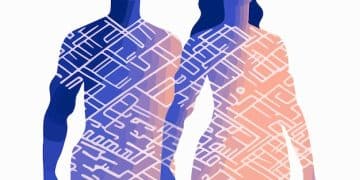Understanding Cholesterol Types & Management

Cholesterol, often misunderstood, is a vital lipid in the body, but its various types, particularly LDL and HDL, significantly impact cardiovascular health, necessitating proactive management through diet, lifestyle, and medical intervention to maintain optimal levels and prevent disease.
For many, the word “cholesterol” conjures images of dietary restrictions and heart worries. Yet, understanding the different types of cholesterol and how to manage them is fundamental, offering a clearer picture of its role in our health.
Decoding Cholesterol: The Essentials
Cholesterol often gets a bad rap, but it’s a crucial fatty substance present in every cell of your body. It plays a vital role in building healthy cells, producing hormones, and aiding in vitamin D synthesis. The liver produces all the cholesterol your body needs, but it can also be obtained through certain foods. The issue isn’t cholesterol itself, but rather its balance and the way it’s transported in the bloodstream.
When discussing cholesterol, it’s essential to recognize that it doesn’t travel freely in the blood. Instead, it’s carried by specific proteins called lipoproteins. These lipoproteins are what we commonly refer to as “good” and “bad” cholesterol, based on their function and impact on cardiovascular health. Understanding this distinction is the first step toward effective management.
What is LDL Cholesterol?
LDL, or low-density lipoprotein, is often branded as “bad” cholesterol. It transports cholesterol from the liver to cells throughout the body. While cells need cholesterol, an excess of LDL can lead to its accumulation in the arteries. This buildup, known as plaque, can narrow the arteries, making them less flexible and hindering blood flow. This process, called atherosclerosis, is a major risk factor for heart attacks and strokes.
- Role: Delivers cholesterol to cells.
- Risk: High levels can lead to plaque buildup in arteries.
- Impact: Increases risk of heart disease and stroke.
The danger of high LDL lies in its insidious nature; it often presents no symptoms until significant damage has occurred. Regular cholesterol screenings are therefore paramount, especially for individuals with risk factors such as family history, obesity, or diabetes. Lifestyle choices, including diet and exercise, significantly influence LDL levels, making them a primary focus in managing cardiovascular health.
The Role of HDL Cholesterol
In contrast to LDL, high-density lipoprotein (HDL) is known as “good” cholesterol. HDL acts as a scavenger, collecting excess cholesterol from the arteries and transporting it back to the liver, where it can be eliminated from the body. This protective action helps prevent the buildup of plaque, reducing the risk of atherosclerosis and related cardiovascular diseases.
- Function: Removes excess cholesterol from arteries.
- Benefit: Helps prevent plaque formation.
- Goal: Higher HDL levels are generally beneficial.
Maintaining adequate HDL levels is a cornerstone of heart health. Factors such as regular physical activity, a balanced diet rich in monounsaturated and polyunsaturated fats, and avoidance of trans fats can contribute to higher HDL. Conversely, sedentary lifestyles and diets high in saturated and trans fats can lower HDL, diminishing its protective effects. It’s not just about lowering bad cholesterol, but also about raising good cholesterol.
Total Cholesterol and Triglycerides
Beyond LDL and HDL, a complete lipid panel provides a broader picture, including total cholesterol and triglyceride levels. Total cholesterol is the sum of all cholesterol in your blood, including LDL, HDL, and other lipoproteins. While it offers a general overview, breaking it down into its components provides more actionable insights into your cardiovascular risk.
Triglycerides are another type of fat found in your blood. Your body converts extra calories into triglycerides, storing them in fat cells for later energy use. High triglyceride levels, combined with high LDL or low HDL, can further increase your risk of heart attack and stroke. These levels are particularly sensitive to diet, with excessive intake of sugars and refined carbohydrates being significant contributors to elevated triglycerides. Managing all these components collectively is crucial for a comprehensive approach to heart health.
In summary, understanding these different types of cholesterol—LDL, HDL, total cholesterol, and triglycerides—is foundational to managing your cardiovascular health. Each plays a distinct role, and a balanced approach addressing all components is essential for preventing heart disease. Regular monitoring and informed lifestyle choices are your best allies in this endeavor.
Diagnostic Tools: Understanding Your Lipid Panel
Knowing your cholesterol numbers is essential for assessing your risk of cardiovascular disease. This information is typically obtained through a simple blood test called a lipid panel or lipid profile. This test measures your total cholesterol, LDL cholesterol, HDL cholesterol, and triglycerides. Interpreting these results with your healthcare provider is crucial for developing a personalized management plan.
The lipid panel provides a snapshot of your fat levels in the blood at the time of the test. Often, fasting for 9 to 12 hours before the test is required to ensure accurate triglyceride measurements, as recent food intake can significantly impact these levels. Discussing any medications or supplements you’re taking with your doctor beforehand is also important, as some can influence results.
What Do the Numbers Mean?
Understanding the typical ranges for each component of your lipid panel can help you grasp your results:
- Total Cholesterol: Generally, less than 200 mg/dL is considered desirable. Levels between 200 and 239 mg/dL are borderline high, and 240 mg/dL and above are considered high.
- LDL Cholesterol: Optimal LDL is less than 100 mg/dL. Near optimal is 100-129 mg/dL. Borderline high is 130-159 mg/dL, high is 160-189 mg/dL, and very high is 190 mg/dL and above.
- HDL Cholesterol: For HDL, higher numbers are better. Less than 40 mg/dL is considered a major risk factor for heart disease. 40-59 mg/dL is good, but 60 mg/dL and above is considered protective against heart disease.
- Triglycerides: Normal triglyceride levels are less than 150 mg/dL. Borderline high is 150-199 mg/dL, high is 200-499 mg/dL, and very high is 500 mg/dL and above.
These are general guidelines, and your target levels might differ based on your overall health, age, family history, and other risk factors for heart disease. Your healthcare provider will interpret these numbers in the context of your complete medical profile.
When to Get Tested
The American Heart Association recommends that adults aged 20 or older have their cholesterol checked every four to six years. However, more frequent screenings may be necessary if you have certain risk factors, such as a family history of high cholesterol or heart disease, diabetes, high blood pressure, or if you are overweight or obese. Your doctor will advise on the appropriate frequency based on your individual health profile.

Early detection allows for timely intervention, whether through lifestyle modifications or medication, potentially preventing more severe health issues down the line. It’s a proactive step in managing your long-term cardiovascular well-being. Don’t wait for symptoms; regular monitoring is a key preventative measure.
In essence, the lipid panel is a powerful diagnostic tool that offers valuable insights into your cardiovascular health. Understanding what each number means and discussing your results with a healthcare professional are critical steps in taking control of your cholesterol levels and mitigating your risk of heart disease. It’s an investment in your future health.
Dietary Strategies for Cholesterol Control
The foods we consume profoundly impact our cholesterol levels. While diet alone may not resolve all cholesterol issues, it plays a significant role in managing LDL, HDL, and triglyceride levels. Adopting heart-healthy eating habits is often the first line of defense against unfavorable lipid profiles and a cornerstone of cardiovascular wellness.
Shifting to a diet focused on whole, unprocessed foods is a generally effective approach. This includes prioritizing fruits, vegetables, whole grains, and lean proteins, while limiting foods high in saturated and trans fats. Small, consistent dietary changes can yield considerable benefits over time, making this a sustainable strategy.
Embrace Soluble Fiber
Soluble fiber, found in foods like oats, barley, apples, citrus fruits, and beans, can help lower LDL cholesterol. It forms a gel-like substance in the digestive tract that binds to cholesterol and prevents its absorption. This means less cholesterol enters your bloodstream, helping to reduce overall levels. Integrating a variety of fiber-rich foods daily can make a noticeable difference.
- Sources: Oats, barley, apples, citrus fruits, beans.
- Mechanism: Binds to cholesterol, preventing absorption.
- Benefit: Lowers LDL cholesterol.
Starting your day with a bowl of oatmeal or adding beans to your salads and soups are simple ways to boost your soluble fiber intake. It’s a natural and effective way to support healthy cholesterol levels without resorting to drastic dietary overhauls. Consistency is key when it comes to dietary changes.
Focus on Healthy Fats
Not all fats are created equal. While saturated and trans fats are detrimental to cholesterol levels, monounsaturated and polyunsaturated fats can actually improve them. These healthy fats can help lower LDL cholesterol and, in some cases, even raise HDL cholesterol.
Sources of monounsaturated fats include olive oil, avocados, and nuts like almonds and pecans. Polyunsaturated fats are found in vegetable oils (like sunflower and corn oil) and fatty fish such as salmon, mackerel, and tuna, which are rich in omega-3 fatty acids. Omega-3s are particularly beneficial for lowering triglycerides and may also offer anti-inflammatory benefits.
- Monounsaturated Fats: Olive oil, avocados, nuts.
- Polyunsaturated Fats: Vegetable oils, fatty fish (omega-3s).
- Impact: Lower LDL, may raise HDL, reduce triglycerides.
Minimizing saturated fats, commonly found in red meat, high-fat dairy products, and processed foods, is also crucial. Trans fats, often present in fried foods and many baked goods, should be eliminated from the diet entirely due to their severe negative impact on cholesterol and heart health. Reading food labels to identify and avoid these components is an essential habit for heart health.
Limit Dietary Cholesterol, Sugars, and Refined Carbs
While dietary cholesterol has less impact on blood cholesterol for most people than saturated and trans fats, it’s still prudent to moderate intake, especially if you have high cholesterol. Foods high in dietary cholesterol include organ meats, egg yolks, and shellfish. More importantly, limiting added sugars and refined carbohydrates is vital for managing triglycerides. Excess sugar in the diet is converted into triglycerides by the liver, leading to elevated levels. Opting for whole grains over refined grains, and fruit over sugary drinks, can immensely benefit your lipid profile.
Adopting these dietary strategies represents a powerful, proactive approach to managing your cholesterol. It’s about making informed choices that support your cardiovascular system over the long term. Small, consistent changes collectively contribute to a healthier heart and a more balanced lipid profile.
Lifestyle Modifications Beyond Diet
While diet is a cornerstone of cholesterol management, lifestyle choices extend far beyond what’s on your plate. Regular physical activity, maintaining a healthy weight, quitting smoking, and managing stress are equally vital components. These habits work synergistically with dietary changes to improve your lipid profile and reduce your overall risk of cardiovascular disease.
Adopting a holistic approach means recognizing that every aspect of your daily routine influences your health. Even small, incremental changes in lifestyle can accumulate into significant benefits for your heart and overall well-being. It’s about building sustainable habits gradually.
The Power of Regular Exercise
Physical activity is a potent tool for cholesterol management. Regular exercise can significantly raise HDL (“good”) cholesterol, decrease harmful triglycerides, and even modestly lower LDL (“bad”) cholesterol. It also helps with weight management, lower blood pressure, and improve insulin sensitivity, all of which contribute to better heart health.
- Impact: Raises HDL, lowers triglycerides, modest LDL reduction.
- Recommendation: Aim for at least 150 minutes of moderate-intensity aerobic activity or 75 minutes of vigorous-intensity activity per week.
- Benefits: Supports weight management, improves blood pressure.
Activities such as brisk walking, jogging, swimming, cycling, or dancing are excellent choices. Even breaking up long periods of sitting with short bursts of movement can be beneficial. Consistency is more important than intensity initially; find activities you enjoy to ensure long-term adherence. Making exercise a regular part of your routine is an investment in your cardiovascular health.
Weight Management and Cholesterol
Excess body weight, particularly around the abdomen, can negatively impact cholesterol levels. Being overweight or obese tends to increase LDL cholesterol and triglycerides while simultaneously lowering HDL cholesterol. Losing even a modest amount of weight can lead to significant improvements in your lipid profile.
Weight loss contributes to better cholesterol numbers by reducing the amount of fat available for the liver to produce cholesterol. It also improves the body’s ability to clear LDL from the blood and enhances HDL function. Achieving and maintaining a healthy weight through a combination of diet and exercise is a highly effective strategy for cholesterol control and overall metabolic health.
- Effect: Reduces LDL and triglycerides, increases HDL.
- Strategy: Combine healthy eating with regular exercise.
- Outcome: Improved lipid profile and metabolic health.
Focus on gradual, sustainable weight loss rather than quick fixes. Small changes that you can stick with over time are more likely to lead to lasting success and improved cholesterol numbers. A healthy BMI is a good target, but even a 5-10% reduction in body weight can have a positive impact.
Quitting Smoking and Stress Management
Smoking severely damages blood vessels and significantly lowers HDL cholesterol levels, making it harder for your body to remove excess cholesterol from your arteries. It also increases total cholesterol and promotes hardening of the arteries. Quitting smoking is one of the most impactful steps you can take to improve your cholesterol levels and overall cardiovascular health. The benefits are almost immediate and continue to grow over time.
Chronic stress can also indirectly affect cholesterol by promoting unhealthy coping mechanisms like overeating or inactivity, and by influencing hormonal balances that impact lipid metabolism. Finding healthy ways to manage stress, such as mindfulness, meditation, yoga, or spending time in nature, can indirectly support better cholesterol levels and overall well-being. Managing stress is part of a comprehensive approach to heart health.
Incorporating these lifestyle modifications into your daily routine offers a powerful, non-pharmacological approach to managing cholesterol. They not only improve your lipid profile but also enhance your overall vitality and reduce the risk of numerous other chronic diseases. It’s a holistic approach to living a healthier life.
Medication as a Management Tool
Despite diligent efforts in diet and lifestyle modifications, some individuals may still struggle to achieve optimal cholesterol levels. In these cases, medication becomes a crucial component of a comprehensive management plan. The decision to prescribe medication is typically based on a patient’s overall cardiovascular risk profile, not just individual cholesterol numbers.
Healthcare providers consider a range of factors including age, gender, family history of heart disease, blood pressure, and the presence of conditions like diabetes when determining the need for medication. Statins are the most commonly prescribed class of drugs, but other options are available to address specific cholesterol challenges or patient needs.
Statins: The First Line of Defense
Statins are a class of drugs that work by blocking an enzyme in the liver that produces cholesterol. This action significantly lowers LDL (“bad”) cholesterol and can also reduce triglycerides and modestly increase HDL (“good”) cholesterol. They are highly effective in reducing the risk of heart attacks, strokes, and other cardiovascular events.
- Mechanism: Block cholesterol production in the liver.
- Primary Effect: Lower LDL cholesterol.
- Benefit: Significantly reduce cardiovascular event risk.
Common statins include atorvastatin (Lipitor), simvastatin (Zocor), rosuvastatin (Crestor), and pravastatin (Pravachol). While generally well-tolerated, potential side effects can include muscle pain, liver dysfunction, or, less commonly, an increased risk of type 2 diabetes. Close monitoring by a healthcare provider is essential to manage any side effects and ensure the medication’s effectiveness. The benefits of statins in preventing adverse cardiovascular events often far outweigh these potential risks.
Other Cholesterol-Lowering Medications
When statins are not sufficient, or if a patient cannot tolerate them, other medications may be prescribed. These include:
Ezetimibe (Zetia): This medication works by reducing the absorption of cholesterol from the intestine into the bloodstream. It’s often used in combination with a statin for additive LDL lowering effects, or alone for patients who cannot take statins.
PCSK9 Inhibitors: These are newer, injectable medications that significantly lower LDL cholesterol, particularly in individuals with very high LDL levels or those who haven’t responded well to other therapies. They work by deactivating a protein called PCSK9, which normally breaks down LDL receptors on liver cells. By blocking this protein, more LDL receptors are available to clear LDL cholesterol from the blood.

Bile Acid Sequestrants: These drugs bind to bile acids in the intestine, preventing their reabsorption and promoting their excretion. As the body needs bile acids for digestion, it draws cholesterol from the blood to make more, thereby lowering blood cholesterol levels.
Fibrates: Primarily used to lower very high triglyceride levels, fibrates can also have a modest effect on increasing HDL cholesterol. They activate a protein that helps reduce triglyceride production and increase their removal from the blood.
Niacin (Nicotinic Acid): Niacin is a B vitamin that can lower LDL cholesterol and triglycerides while raising HDL cholesterol at prescription doses. However, it can cause significant side effects, such as flushing, and is generally used with caution and under strict medical supervision.
The choice of medication depends on the specific type of dyslipidemia, the severity of cholesterol imbalance, and individual patient tolerance. It’s a collaborative decision between patient and doctor, always integrated with ongoing dietary and lifestyle modifications. Regular follow-up appointments are essential to monitor efficacy and adjust treatment as needed, ensuring the best possible outcome for cardiovascular health.
Future Outlook and Emerging Research
The landscape of cholesterol management is continuously evolving, driven by ongoing research into the complex mechanisms of lipid metabolism and cardiovascular disease. Scientists are exploring novel therapeutic targets, personalized medicine approaches, and advanced diagnostic tools that promise to refine how we understand, prevent, and treat high cholesterol in the future.
The focus is gradually expanding beyond just lowering LDL cholesterol to understanding the quality of lipoproteins, the role of inflammation, and genetic predispositions. This holistic perspective aims to offer more tailored and effective interventions for individuals at varying levels of risk.
One significant area of exploration is the role of genetics in determining an individual’s cholesterol profile and response to treatment. Genetic testing may eventually help predict who is at highest risk for certain cholesterol-related conditions and guide the selection of the most effective medications.
Advanced Diagnostics and Risk Prediction
Beyond the standard lipid panel, researchers are investigating more sophisticated diagnostic markers. These include measuring lipoprotein(a) [Lp(a)], a genetic variant of LDL cholesterol that carries an independent, often significant, risk for heart disease, and apolipoprotein B (apoB), which reflects the total number of atherogenic (plaque-forming) particles. Understanding these markers can provide a more nuanced assessment of cardiovascular risk, particularly for those with otherwise “normal” cholesterol levels but a strong family history of heart disease.
Additionally, advanced imaging techniques, such as coronary artery calcium (CAC) scoring, are becoming more prevalent. CAC scoring directly visualizes calcium deposits in the coronary arteries, serving as a powerful predictor of future cardiovascular events. When combined with traditional risk factors and lipid profiles, these more precise diagnostic tools allow for earlier and more targeted interventions, especially in asymptomatic individuals.
Novel Therapeutic Approaches
The development of PCSK9 inhibitors marked a significant breakthrough, but the pipeline for new cholesterol-lowering drugs continues to grow:
Inclisiran: This is a revolutionary short interfering RNA (siRNA) therapy that harnesses the body’s natural cellular machinery to block the production of the PCSK9 protein. Administered twice a year after an initial loading dose, it offers sustained LDL reduction, potentially transforming adherence for patients compared to more frequent dosing regimens.
Lp(a)-Targeted Therapies: Given the distinct risk associated with elevated Lp(a), several therapies are in development to specifically lower this type of cholesterol. These include antisense oligonucleotides that target the production of Lp(a) in the liver, showing promising results in clinical trials.
Gene Editing Technologies: While still largely in experimental stages, gene editing tools like CRISPR are being explored for their potential to permanently modify genes associated with high cholesterol, such as those involved in PCSK9 production or familial hypercholesterolemia. This could offer one-time treatments for lifelong management of severe lipid disorders.
Inflammation Pathways: Beyond lipid levels, inflammation plays a critical role in atherosclerosis. Therapies targeting inflammatory pathways, such as canakinumab (which targets interleukin-1 beta), have shown some promise in reducing cardiovascular events, suggesting a multi-faceted approach to heart disease prevention beyond just cholesterol. While not directly lowering cholesterol, these drugs address the inflammatory component of arterial plaque formation.
These burgeoning research areas highlight a future where cholesterol management is increasingly personalized, leveraging genetic information, advanced diagnostics, and innovative drug mechanisms to provide more effective and convenient treatments. The goal remains to move closer to a world where cardiovascular disease is largely preventable or effectively managed, improving quality of life for millions.
| Key Aspect | Brief Description |
|---|---|
| 📊 Cholesterol Types | LDL (“bad”) contributes to plaque; HDL (“good”) removes excess cholesterol. |
| 🍏 Dietary Fixes | Embrace soluble fiber & healthy fats; limit saturated fats & refined sugars. |
| 🏃♀️ Lifestyle Impact | Exercise, weight management, and quitting smoking significantly improve levels. |
| 💊 Medication Options | Statins and other drugs help when lifestyle changes are insufficient. |
Frequently Asked Questions About Cholesterol
▼
LDL (low-density lipoprotein) is often called “bad” cholesterol because high levels can lead to plaque buildup in arteries, increasing heart disease risk. HDL (high-density lipoprotein) is “good” cholesterol, as it helps remove excess cholesterol from arteries, returning it to the liver for excretion. A healthy balance is essential.
▼
For many, particularly those with borderline high cholesterol, significant improvements can come from lifestyle adjustments like a heart-healthy diet, regular exercise, and weight management. However, for some, especially those with genetic predispositions or very high levels, medication may be necessary in conjunction with lifestyle changes to achieve optimal control.
▼
To help manage cholesterol, it’s best to limit foods high in saturated fats (found in red meat, full-fat dairy, and many processed snacks) and trans fats (often in fried foods and baked goods). Also, excessive intake of added sugars and refined carbohydrates can increase harmful triglycerides. Focus on whole, unprocessed foods.
▼
The American Heart Association generally recommends that adults aged 20 or older have their cholesterol checked every four to six years. However, if you have strong risk factors like a family history of heart disease, diabetes, or high blood pressure, your doctor might recommend more frequent screenings. Consult your physician for personalized advice.
▼
Like all medications, cholesterol-lowering drugs, primarily statins, can have side effects. Common ones include muscle pain, digestive issues, or, rarely, liver problems. Serious side effects are uncommon. It’s crucial to discuss any concerns or symptoms with your healthcare provider, who can adjust your treatment plan or recommend alternative medications if needed.
Conclusion
Understanding the nuances of cholesterol, from its various types to effective management strategies, is a pivotal step in safeguarding your cardiovascular health. It’s clear that while cholesterol plays an indispensable role in bodily functions, maintaining a healthy balance of its different forms is crucial to prevent serious heart conditions. By embracing informed dietary choices rich in soluble fiber and healthy fats, integrating regular physical activity into your routine, managing your weight effectively, and adopting stress-reduction techniques, you empower yourself to significantly influence your lipid profile. For many, these lifestyle modifications will be sufficient; for others, medical intervention, guided by skilled professionals, provides the necessary complement to achieve optimal levels. Emerging research hints at an exciting future where personalized medicine, advanced diagnostics, and novel therapies offer even more precise and effective ways to combat cholesterol imbalances. Ultimately, taking charge of your cholesterol through a combination of awareness, proactive lifestyle choices, and professional medical guidance is an enduring investment in a longer, healthier life.





